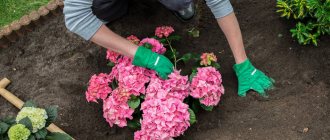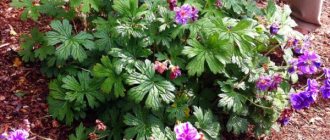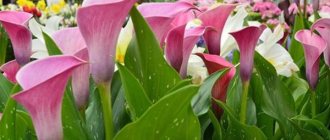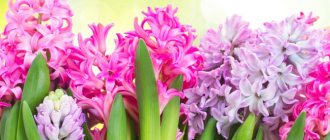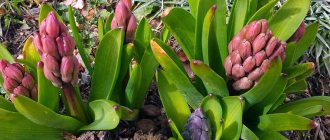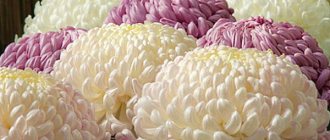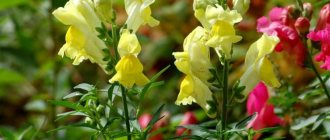Description of garden perennial fuchsia
Fuchsia owes its name to the German doctor L. von Fuchs, considered the “father of botany.”
Fuchsia branches are distinguished by their flexibility and downward direction of the crown.
What does a flower look like
The leaves have a bright green color and an oval shape. Their length is approximately 5 cm. The ends are pointed, and the edges of the leaves have a jagged border. The stems have a light reddish color. Sometimes the foliage also takes on this shade.
The flowers of the plant are single, directed downwards. They are shaped like a bowl. Flowers are double, simple and semi-double. Their color varies: there is orange, lilac, cream, white, pink, blue and violet.
Double flowers
Flowering continues for a long period of time. At this time, the flowers rush downwards more and more and fade towards the end of flowering.
Fuchsia is an annual or perennial plant
Fuchsia belongs to the genus of exotic perennial plants. But since this is a heat-loving flower, it is classified as an annual in northern latitudes.
Planting fuchsia
There are many hybrid varieties that are quite frost-resistant, but for the most part fuchsias are heat-loving plants. In the garden, windless corners with sufficient lighting or slightly shaded are perfect for her. Prefers neutral, fertile soils.
Fuchsias are planted in open ground at the end of May - June. When planting, make sure that the root collar is buried no more than 20 cm. After rooting, the plants intensively gain strength and begin to bloom (about 2.5 weeks). Before being dug up for the winter, the plant must survive the first frost, thus undergoing some hardening before winter dormancy.
Possible diseases: general information
The advantage of the plant is its low susceptibility to disease. Most often, signs of powdery mildew may appear on the bush. Fundazol will help cope with the disease (see the dosage on the package). Other possible problems include gray or black rot. The affected part of the bush becomes watery, and a whitish coating forms on the surface of the foliage. The fight against diseases consists of timely removal of dead parts and treatment with disinfectant chemicals.
The fuchsia bush can be affected by pests - aphids, spider mites, whiteflies. Signs of aphid infestation are pale color and curling of foliage, bending of stems, and non-opening of buds. Treating the leaves with alcohol and then spraying them with any preparation from the group of insecticides will kill the pest.
If the humidity is low, fuchsia becomes infested with spider mites. Symptoms are specks and dots on the leaves, their discoloration and subsequent falling off. Pest control also involves treatment with insecticides.
Fuchsia is a beautiful flower that is mainly grown in pots, flowerpots and decorative containers. When growing in the garden, it is important to adhere to special care rules. You need to sow seeds in a container in February, and plant seedlings in open ground in May. Soil fertility and moderate humidity are important for the plant. You can recognize the first signs of fuchsia diseases in the garden by the leaves.
Is it possible to plant fuchsia in open ground?
Fuchsia is grown as an outdoor flower not only in hanging baskets, stationary flowerpots, but also in flower beds. True, in all regions in the fall the bushes will have to be dug up from open ground and brought indoors.
Culture loves fresh air. If you choose the right planting location, fuchsia grows faster outdoors and blooms more profusely than at home.
Almost all species, varieties and hybrids feel better in the middle zone than in the south. In cool climates, bushes suffer less from heat in summer - despite the fact that the plant is tropical, it does not like high temperatures.
How to shape fuchsia
To get a thick, branched bush, pinch the flower as it grows. The first pinch is done after the cutting has taken root. Pinch (remove) the upper part of the shoot, thus stimulating the lateral buds to grow and flower.
The shoots that grow from them are also pinched, leaving 2-3 nodes for branching. Thus, you can form a lush plant in 3-4 pinchings. Shoots growing from the ground are also pruned.
Pinching the plant plays the role of formative and rejuvenating pruning and prevents the stems from becoming bare.
Shoots of hanging and hanging varieties are shortened by a third of their length in the spring. It is important that the branches of the flower are the same on all sides. Then during the flowering period the bush will be harmonious and uniform. In an adult plant, pinch out every 3-4 internodes.
Fuchsia is a flexible plant, it grows quickly; bush and hanging varieties can be used to form a standard.
Fuchsia on a trunk
The grown cuttings are tied to a support in several places. The lower leaves and branches on the future trunk are removed, leaving 3-4 pairs of leaves at the crown. The top is pinched after the plant reaches the desired height. After this, the stage of crown formation begins, pinching the shoots after 2 - 3 internodes. Over time, the fuchsia trunk becomes woody and the crown branches out.
A thicker trunk can be obtained by weaving 2-3 shoots of one plant.
Fuchsia blooms on young shoots. The shorter the pinching (1-3 buds), the better the young shoots develop.
Fuchsia propagation
1. Seeds
- used if desired to experiment with selection. Plants grown from seeds may lose their parental varietal qualities, and there is more hassle. But if you decide to grow fuchsia from seeds, plant them in containers in March-April, lightly sprinkling them, or even better, use peat tablets for planting, which can then be immediately replanted without disturbing the root system of the plant. After planting, keep the containers at a temperature of 16-18 ° C; the seeds will germinate in about 3 weeks.
2.
Vegetatively
— as a rule, cuttings are used. To do this, choose slightly woody shoots that are rooted in water or a liquid substrate or sand. Roots will appear within 1-2 weeks. Bush and ampelous plants take cuttings every three years, thus renewing the plant. Three-leaved fuchsia is also propagated by cuttings, which results in abundant flowering.
Growing fuchsia: seeds, cuttings and leaves
This plant is rarely grown from seeds. Firstly, the stores offer a very small range of varieties. Secondly, when grown from its own seeds, the plant will look different from its parent.
But if you still purchased seeds, then you need to plant them in home soil in February.
Moisten the soil with manganese solution and bury the seeds in it. There is no need to cover the planting material with soil on top. The container must be covered with glass or plastic film and placed in the shade at a temperature not lower than +18 degrees. Caring for fuchsia at the germination stage involves moderate watering when you notice that the soil is very dry. This plant does not like excessive waterlogging. After a month, shoots will appear, then the cover from the container is removed. When four leaves are formed, the fuchsia is transplanted to a permanent place, where it will wait for the summer season. Many gardeners plant fuchsia from cuttings. It is better to take young shoots at least 10 cm long and with fresh leaves. Make sure that their ends are not dry. Rooting of cuttings begins in the spring.
In summer, conditions are not suitable for this due to elevated air temperatures.
And in the fall, fuchsia is in a dormant stage, so you may not expect any roots from it.
The cuttings can be planted either in the ground or in water. Fuchsia is also grown from the leaf. To do this, you need to take a large sample with a petiole and part of the cutting with a bud. Such planting material is planted in soil consisting of moss, peat and vermiculite.
Place the nutrient substrate in the container and moisten it. Place the leaf in a hole previously made in the substrate and sprinkle. Cover the top of the container with glass. The leaf should form roots in three weeks, then it can be replanted.
Fuchsia is planted in open ground at the beginning of summer. Before this, a hole is formed in the ground, which is 15 cm deeper than the container of the pot. Drainage material is poured onto its bottom, and turf, compost and manure are placed on top. Fuchsia is planted in open ground along with a lump that forms around its roots. After planting, sprinkle the plant with the soil to which it is accustomed while in the pot.
Fuchsia in open ground is watered only when its top layer begins to dry out. It is recommended to do this either in the morning or in the evening. As care, you should periodically remove its wilted flowers.
Storing fuchsia in winter
Usually, before the onset of real cold weather, plants are dug up, previously cut to half.
They are usually placed in a container, close to each other. Ensuring rest comes down to reducing watering to once a week and keeping the plants at a temperature not exceeding 10 ° C so that the fuchsia does not start to grow. After the leaves fall, the fuchsia can be removed to a dark room with watering once a month. My fuchsia overwintered in an unheated bathhouse in a container mixed with sand and earth in a tin bucket, covered with old cotton blankets. And she survived the winter! This indicates good endurance, but still it is not worth taking unnecessary risks; it is better to ensure constant temperature conditions.
Starting in March, we bring fuchsia back to life. To do this, we cut its shoots to 15 cm and replant them in a new nutrient soil mixture, increasing watering.
detailed instructions
When choosing a place for a plant, you should give preference to places that are well lit in the morning and evening and shaded during the day. Fuchsia should be planted in open soil no earlier than May. The bush is characterized by rapid rooting and strengthening - the plant will bloom within 2-3 weeks after planting. The plant does not tolerate cold weather. For long-term cultivation, fuchsias are best grown in pots, moving them outside in warm temperatures.
Soil composition and fertilizers
You need to sow seeds in light and nutritious soil. You can buy a ready-made soil mixture or make it yourself from turf soil, peat and sand (proportions 3:2:1). It is advisable to disinfect the soil - keep it in the refrigerator or in the cold, pour boiling water over it. Seeds are planted in such a soil mixture for further transplantation of seedlings to a garden plot.
It is necessary to plant seedlings in the garden in fertile soil with a neutral reaction. The quality of the soil on the site will be improved by adding a top layer of a mixture of peat, perlite and sand. It is also advisable to add clay - it will help retain nutrients.
The preferred garden soil composition should include:
- turf mixture or leaf soil;
- peat;
- settled humus and compost;
- sand.
Important! It is necessary to maintain soil moisture: the top layer should not dry out, but moisture should not accumulate in the root system.
Among the preferred fertilizers are biological fertilizers. It is allowed to apply after the plant has taken root and has produced full foliage. For these purposes, use liquid fertilizers based on humus, fertilizing with nitrogen, phosphorus, potassium, and zinc. Soil feeding must be alternated with surface spraying of leaves against pests (weak solution of Previkur, potassium permanganate).
Preparation and germination
The main condition for high-quality germination is purchasing fresh seeds from trusted producers. The seeds need to be planted in the soil in February-March, then the seedlings can be planted in open ground in mid-May. The container for fuchsia should be spacious. A suitable container is a transparent container.
Holes should be made at the bottom of the container for drainage. Next, make a layer of expanded clay or pebbles - the seedlings will not die from stagnant water. Then you need to pour in the soil mixture, compact it, and leave 2-3 cm to the edge of the container. To prevent the formation of mold, the soil must be sprayed from above with potassium permanganate from a spray bottle.
Deepen the seed with your finger 3-5 cm. Cover the container with cellophane or a lid, be sure to leave room for air to enter. Place on a warm windowsill. The optimal temperature is no higher than 22 degrees. After the first shoots appear, drip water on it once every 2 days, and spray the air with water from a spray bottle every day.
How to care?
Among the basic rules is proper watering of seedlings and adult plants. Fuchsia requires abundant but moderate watering. It is preferable to carry it out 1-2 times a week. Water should be added in the morning. Between waterings, be sure to spray the leaves with a spray bottle, as the plant loves moisture. If the bud has withered, it must be cut off in a timely manner.
There are also some special care features. In the garden, the “precious beauty” is given a place protected from the sun and draft. If all conditions are met, the plant will transform and delight with color: the color will become juicier, lush greenery will grow, and the bush will become stronger.
The optimal temperature for growing outdoors is 21-23° (the figure should not be higher even in summer). If the thermometer mark rises to 26-28, the fuchsia sheds its leaves and begins to fade.
Why doesn't fuchsia bloom?
Why fuchsia doesn’t bloom, what to do, how to care for fuchsia
A healthy plant may refuse to bloom, and then you need to look for the reasons for this phenomenon. They may be different, but the root is the same - improper care. The main problems are as follows:
- the plant overwintered in a warm place;
- there are practically no useful substances left in the soil;
- very frequent watering;
- the pot is of the wrong size;
- there is very little light, the lack of which inhibits active growth and bud formation.
To ensure fuchsia flowering, these problems must be eliminated. If the wintering was warm, after it the shoots are severely pruned. If the pot is unsuitable, organize a flower transplant. The roots should not protrude from the pot and should not feel too open, otherwise the fuchsia will begin to form green shoots and will not bloom.
How to grow fuchsia: growing conditions
Fuchsias love bright, diffused light, but do not tolerate direct sunlight. For most varieties, the most optimal placement option in a room is an eastern or northwestern window sill with good diffused lighting during the day and soft morning or evening sun. It is believed that the darker the fuchsia color, the brighter the lighting should be.
These plants do not like too much heat: fuchsia will feel most comfortable at a temperature of 18°C to 25°C, so in the summer it is advisable to place it in the shade on a balcony or place it outdoors in the country. Fuchsias tolerate temperatures above 26°C rather poorly, especially in the absence of free air circulation. In hot summer weather, plants love spraying. For example, if the twigs and leaves are slightly wilted and the soil in the pot is damp, instead of watering the plant, it is better to spray it with a spray bottle - this way you will restore the elasticity of the green mass and not flood the root system.
Fuchsias like regular watering
settled water at room temperature: the soil in the pot should always be slightly moist. When kept cool in winter, the pot dries out slowly, so watering the plant once every 7-10 days is sufficient. In hot weather, the soil dries out very quickly, and the plant requires frequent (sometimes even daily) watering. To prevent moisture stagnation at the roots, drain the remaining water from the pan 10-15 minutes after watering.
During the period of active growth and flowering, fuchsias are fertilized with complex mineral fertilizer for flowering plants approximately once every 1-2 weeks. During the dormant period, when the plant is resting, no fertilizer is required - only watering is needed to prevent the earthen clod from drying out, which is detrimental to fuchsia.
During flowering, fuchsia should not be turned or moved from place to place, as stress can cause the plant to drop all its flowers and buds. To form a beautiful crown in the spring, the growing shoots are pinched so that they bush more actively. From mid-May, pinching shoots is no longer recommended, so as not to interfere with flowering.
Proper cultivation and care of fuchsia in the garden
Fuchsia belongs to the genus Fireweed perennial plants. It is an unpretentious flower that grows both at home and in the garden.
This plant is remembered for its spectacular flowering, unlike any other flower. Another name for fuchsia is “Japanese lantern”, as flower growers call it because of the unusual shape of the buds. Read more about growing and caring for beautiful and unpretentious fuchsia in our article.
Diseases and treatment
Most often, fuchsia becomes susceptible to disease due to improper care, and pests can appear when using contaminated soil. To avoid diseases, it is enough to observe the temperature and watering regime. Disinfecting the soil will help prevent the proliferation of parasites. Disinfection can be done by calcination in the oven, freezing or steaming in a water bath.
Below we will look at possible problems and ways to solve them.
Root rot
Signs of root rot can be noticed when the plant is replanted annually: the roots become sluggish and turn brown. It is necessary to combat the disease by removing soil from the roots and rinsing them in warm water. After this, you need to cut off the affected areas of the root system with scissors.
Gray rot
With this disease, fuchsia leaves become covered with plaque, and individual shoots begin to rot, becoming soft and watery. This happens mainly in the autumn-spring period, when it is humid outside, the snow is melting or it is constantly raining.
Nutrient deficiencies
Fuchsia leaves serve as an indicator of its health: if they dry out, despite abundant watering, the flower does not have enough molybdenum. Yellowing indicates a lack of manganese, and if the leaves turn white, fertilizer with nitrogen will help revive the plant.
Whitefly
This is a miniature pest butterfly that lays eggs on the undersides of leaves. Its larvae feed on fuchsia juice, and the plant stops blooming and begins to rapidly fade. To get rid of the scourge, you need to cover the soil with a film (to protect the roots) and spray the plant with a solution of soapy water from a spray bottle.
Red spider mite
This parasite feels good in a warm and dry room and often attacks fuchsia in the heat. If you notice small red specks on the plant, a gray coating on the inside of the leaves and cobwebs entwining the stems and shoots, this will mean that the pest has settled on your flower and is building a nest.
Aphid
If you notice atypical formations on the stems and leaves of fuchsia, then take a closer look. Perhaps this is a cluster of aphids. These are small insects that can have a variety of colors: gray, green or brown. They multiply very quickly and deplete the plant. They must be dealt with immediately after detection. Intavir, Decis, and Cypermethrin are suitable for this.
For information on growing and caring for fuchsia, watch the following video.
Wintering fuchsia in open ground
Fuchsia Magellanica feels great under the snow, covered with spruce branches; for other species and resistant hybrids, it is still worth taking a number of necessary measures.
Before the onset of cold weather, we cut our beauty at ground level, sprinkle it with a layer of at least 20 cm of soil, cover it with spruce branches and isolate it from excess moisture, placing another film or roofing material on top. In mid-May, the plant begins to open. From mid-June, growth from the root collar will begin to appear, and only in August will fuchsia begin to bloom.
Many gardeners do it even simpler, rooting new cuttings every year without leaving the plants in the fall. In this case, the cuttings will show miracles of flowering all summer long.
Fertilizer
Fertilizers for fuchsias are applied from early spring to mid-September. It is better to add organic and mineral fertilizers one by one. From organic matter you can take a solution of manure (1:10) - once every 2-3 weeks, from minerals you can use “Ideal” and “Kemira” - once every 4-5 days.
Important! Fuchsias are grateful for feeding and express it with lush flowering. If you use only a third of the fertilizing concentration recommended on the package, you can apply it during each watering.
Fertilizers can only be added to moist soil, and under no circumstances should you add fertilizer if the soil is dry. If you really need it and the soil is dry, you can only use foliar fertilizers.
Fuchsia on the balcony: cultivation and care
Fuchsia does not survive heat and lack of moisture in the air.
This causes the flowers to become small, and sometimes the buds do not open at all. The plant does not tolerate the scorching sun, although the morning rays benefit the flower. From noon until the evening, it is recommended to place the fuchsia in partial shade. Balconies on the east and north sides are best suited for the plant.
Flowerpots
Fuchsia on the balcony is placed in a flower pot so that it does not overheat under the scorching rays of the sun. To do this, you should use blinds or curtains. You can try placing the flower so that the sun hits the foliage and buds and does not affect the roots. To do this, hang it from the wall.
If there is a lack of light and heat, it is necessary to provide the plant with phytolamps or simple fluorescent lamps.
Fuchsia does not respond well to constant movement during flowering. The plant may simply drop all its buds.
Important! Fuchsia needs draft and ventilation.
Fuchsia in a pot on the street
For their beautiful flowering, delicate petals, and elegant stamens, fuchsias are sometimes compared to ballerinas dressed in lacy skirts. Growing such beauty in faceless, monochromatic flower pots is not very aesthetically pleasing; it would seem better to use colorful flowerpots. Fuchsia in a flowerpot looks very presentable, but it may die if the soil is poured directly into the flowerpot, because these decorative vessels do not have drainage holes.
Fuchsia in the wild
In cold regions, all Fuchsia species are planted and grown in various containers with holes for draining water, and then, if desired or necessary, these containers are placed inside a flowerpot.
The need to place a pot with a fuchsia flower outside in a flower pot arises if the weather is hot. For Fuchsia, overheating means death, therefore, in order to protect the root system of the plant, the main florist is placed in a large pot. Thermal insulation materials are poured into the free space between the walls to create a protective layer. It can be expanded clay, sand, ordinary garden soil.
Important! Fuchsia roots need to be protected not only from overheating, but also from overwatering. In waterlogged soil, plants wither and can die very quickly.
Fuchsia in a table pot made of wicker
Fuchsia transplant
It is recommended to transplant during the beginning of the growing season, that is, in the spring.
Before replanting, you need to inspect the roots for mold. The new pot should have dense walls and be spacious enough.
Attention! It is necessary to have drainage to avoid stagnation of water at the root system.
If we talk about transplanting from a home pot to a flowerbed in the spring, then you should wait until the end of May, when the threat of returning night frosts has completely passed. Fuchsia is transplanted into the garden along with a lump of earth using the transshipment method. In the first two weeks, do not feed, water moderately, and carefully observe how the plant takes root.
So that the tree blooms luxuriantly
For the cultivation of fuchsias, both as standard trees and shrubs, certain tricks have been developed. In order for a tree to grow from a fuchsia, be sure to have a lot of patience. During planting, take care of the support; without it, brittle branches will not be able to withstand the wind and heavy rains.
Wherever you plant your lushly blooming beauty - in the ground or in a flower pot, make sure that it is not exposed to the burning rays of the sun. Almost all types of fuchsia do not like them. If you have double varieties, be prepared to be “picky” and have interruptions in flowering. To achieve continuity of abundant color, choose simpler, non-double varieties.
Garden species and varieties of fuchsia
Fuchsia hybrid
Hybrid fuchsia (F. x hybrida) is divided into upright bushes no more than 50 cm high and pyramidal (ampeloid) bushes. Fuchsia flowers are bright, large, with upward-curved cups, different in color from the petals of the flower itself. This gives the flower a special zest. The calyxes can be red, white or pink. The petals of a flower can be red, pink, purple, white.
Varieties of this hybrid are divided into groups:
Diamonds and Sapphires
In this group, the colors combine white and blue, and blue can be represented by purple shades, to bright blue. This contrast is attracting more and more attention from gardeners (varieties Dark Secret, Capri, Ultramarine).
Australian fuchsias
All varieties of this group are very tall, with large, bright flowers. In the second year of development they reach the peak of their decorativeness. Popular varieties: Matilda, Walsing.
Terry exotic
The name itself contains the characteristics of the flowers of this group. Plants vary in color. The flowers are double, small or medium. Popular varieties: Sarah Jane, Florentina, etc.
Fuchsia Royal Mosaic
It is also worth mentioning fuchsias for containers. They are planted in summer and in open ground. Varieties: Anita, Carolina.
Ampelous fuchsias are good on balconies and in hanging baskets, extraordinary flowerpots. The most famous varieties are Cascade and Alice Ashton, but the choice is not limited to them.
In order not to get lost in the variety of colors of fuchsias, plants were classified according to the color of flowers and leaves: one tone, speckled, striped, two-colored.
For example, a group of solid solid colors Dark Secret:
1. Orange (Tangerine Torment)
2. White (Snow in Summer)
3. Tricolor (Silver Dreamers)
Variegated varieties
Characterized by extraordinary multi-colored foliage. Particular decorativeness is achieved by pinching the buds (Tom West variety and many others).
Winter-hardy fuchsias are ideal for the middle zone. They are not afraid of frost and winter well under snow with or without shelter. The most common varieties: Bacon, Garden News, Constance.
Fuchsia variety Bacon
Fuchsia trifolia
Fuchsia triphylla (F. triphylla) is a subshrub up to 50 cm high. The flowers are small, densely coral in color, collected in a small short raceme. The leaves are greenish-red, quite large. Suitable for planting in the ground due to its endurance. But it is rarely planted in the ground; it is usually used in a container version. Varieties: Orient, Express.
Try fuchsia not only at home, but also as a wonderful hanging and garden plant! Its dense, abundant blooms look great in the garden. And if you already have experience growing fuchsia in open ground, share with us
